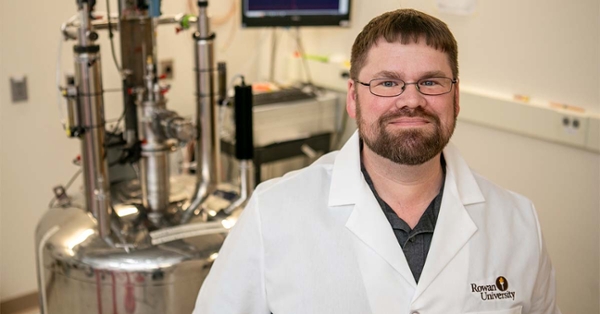NSF CAREER Award: Magnetic resonance adds new twist on the study of carbon dots
NSF CAREER Award: Magnetic resonance adds new twist on the study of carbon dots

Fluorescent nanoparticles called quantum dots are already used in LED lights, solar panels and medical imaging. With a five-year, $432,717 National Science Foundation (NSF) Faculty Early Career Development (CAREER) Award, Rowan University assistant professor Nicholas Whiting will study carbon-based quantum dots in brand-new ways, using hyperpolarized magnetic resonance. The grant is the most prestigious award given by the independent federal agency to early-career faculty.
Whiting holds a dual appointment with the Department of Physics & Astronomy and the Department of Biological & Biomedical Sciences at the College of Science & Mathematics. His interdisciplinary project is funded by the NSF Division of Chemistry and uses methods of physics and chemistry to develop technology for future biomedical applications.
“The groundbreaking work Dr. Whiting is doing can serve as the initial investigation for the development of a new, safe and non-invasive method to detect cancers,” said Vojislava Pophristic, Ph.D., dean of the College of Science & Mathematics. “This type of translatable research is a hallmark of the efforts at Rowan, and continued efforts such as these are critical in growing our reputation as a nationally recognized university.”
Most quantum dots are made of toxic heavy metals. Carbon-based quantum dots are more environmentally friendly.
Quantum dots’ fluorescence is only useful for chemical sensing in transparent systems like cell cultures and test tubes. These particles can’t be used for biomedical applications in non-transparent systems, such as imaging inside the body—but carbon dots can. Unlike other quantum dots, carbon dots have a magnetic resonance signal.
In this project that begins May 1, Whiting is exploring the fundamental science of chemical sensing with magnetic resonance. He will experiment with green methods of synthesizing carbon dots, which can be generated from food and agricultural waste, using brewer’s spent grain obtained from local microbreweries.
Through his work characterizing carbon dots using nuclear magnetic resonance, Whiting will explore particle structure and identify impurities that traditional methods can’t detect, as well as devise better methods of purification.
The magnetic resonance signals that make carbon dots unique “are incredibly weak,” Whiting said. “I use some clever chemistry and physics to temporarily enhance the magnetic resonance signal by orders of magnitude, so you can sense in one second what would take hours otherwise.”
Whiting boosts the strength of this signal through a process known as hyperpolarization. The type of hyperpolarization he will use in this project, called dynamic nuclear polarization, uses extremely low temperatures, high magnetic fields, and microwave irradiation to enhance magnetic resonance signals. With these stronger signals, hyperpolarized carbon dots can simultaneously use both magnetic resonance and optical detection modes of chemical sensing.
Over the course of the project, Whiting anticipates that 30 to 40 students will contribute in capacities like filtering the synthesized carbon dots, enhancing their nuclear magnetic resonance signals and characterizing their properties.
NSF funds research in all 50 states through grants to nearly 2,000 colleges, universities and other institutions. Each year, NSF receives more than 50,000 competitive proposals for funding and makes about 12,000 new funding awards.
“The Whiting research addresses an important component of our Chemical Measurement and Imaging (CMI) portfolio–magnetic resonance,” said Kelsey Cook, Ph.D., the program’s lead and senior adviser in the Division of Chemistry at the National Science Foundation. “In particular, Dr. Whiting is using non-toxic quantum dots to expand applicability of dynamic nuclear polarization– a method prominent in the CMI portfolio because of its remarkable ability to enhance the sensitivity of information-rich magnetic resonance measurements. In common with many NSF research awards, the work can be characterized as ‘high risk with high potential pay-off.’
“Consistent with guidance for the NSF CAREER program, Dr. Whiting has included in his proposal plans for educational and outreach components which will enhance the broader impacts of the work. These components seem assured to enhance the impact of the work and contribute to the enthusiastic support of the program for this project.”